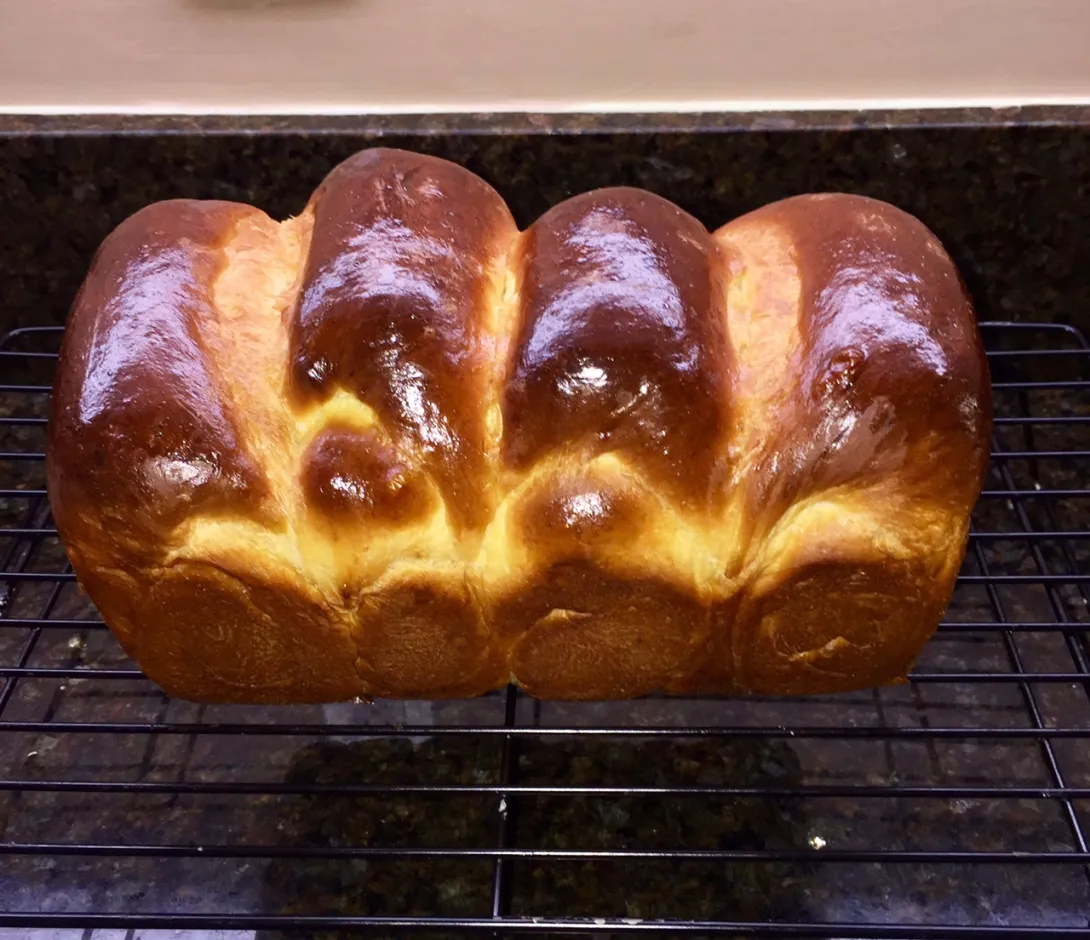
Hi all,
Just made this Hokkaido milk bread.
Floyd, thank you for the inspiration, your words sank into my mind "the silkiest and softest"... yes, it is!
I used a mix of these flours in the final dough: 2 parts of KA AP four and 1part of 00 Antimo Caputo flour.
I utilized the Tangzhong method with a mixture AP four, water and milk, and the final dough had milk and heavy cream. For the second rise, I divided the dough in 4 parts and rolled them this way: rolled each part into an elongated oval, using a rolling pin, then folded both sides to the center lengthwise, flattened it with the rolling pin, and then rolled it into a tube, pinching seems. Both resting stages took about 1 hour and 15 min. I baked it at 350F, for almost 40 min.
My observations: the dough is super fun to work with; the tangzhong method that I used for the first time, really impressed me; the bread is unreal, cloud-like look, the lightest, and yes, "the silkiest and softest", and my family absolutely loved it!
This bread is a must to bake, and its destined for success!
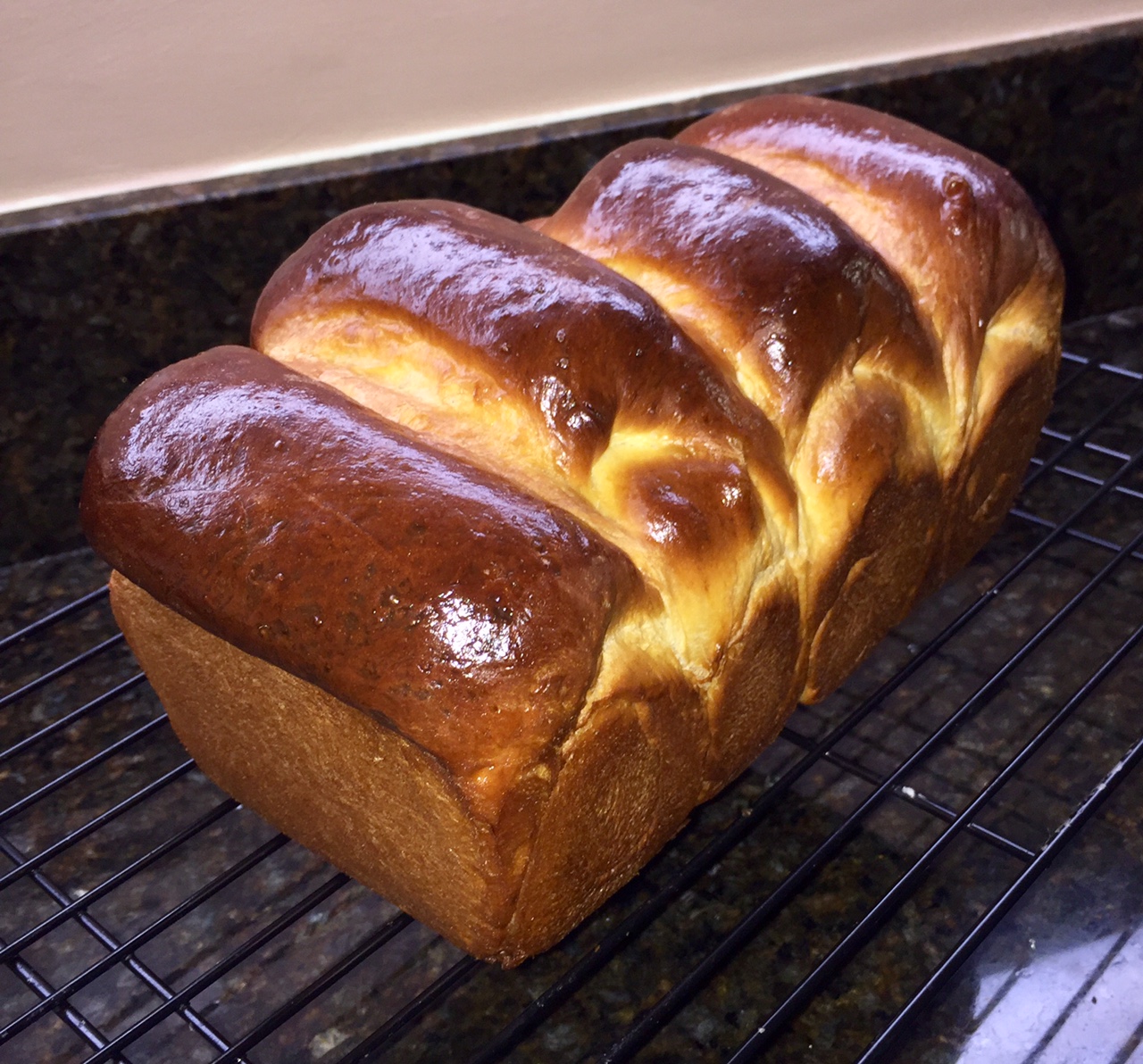
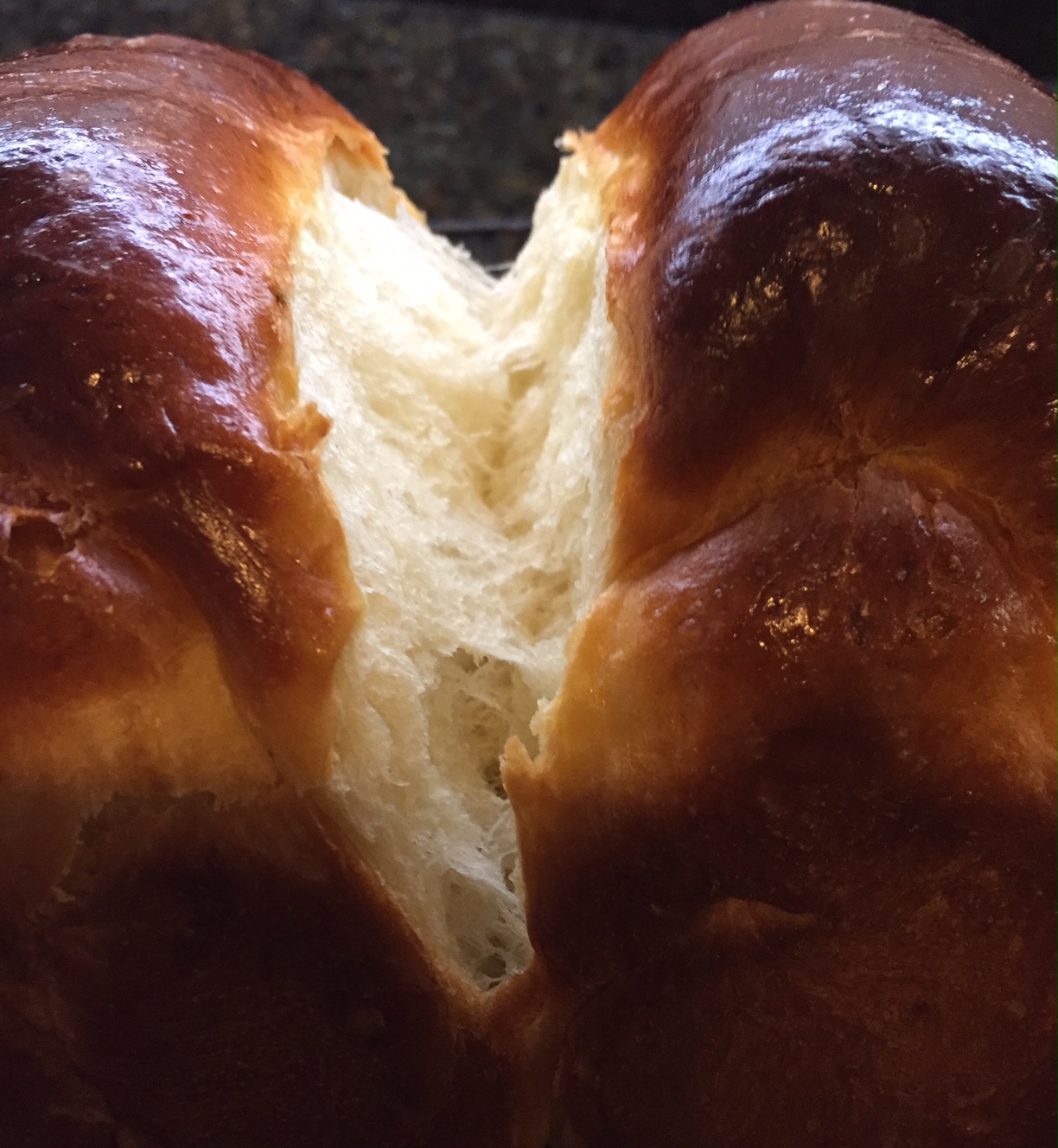
Happy baking!
It just has to taste as good as it looks, with all of the work that you put in to the preparation.
Thanks for sharing!
yes, it's so so yummy, can't resist it lol...thank you!
Looks great. :)
It really is an amazing bread!
fun to make. I've gone total Japanese with this bread and make it with yeast water. Even more soft and fluffy, hard to believe, the kind of crumb only yeast water can give to bread. Well done indeed and happy baking Stella
I would love to try it too! I am always opened for new experents...
the bread was absolutely delightful! thank you very much!
how should I adapt a milk bread recipe to make it with the yeast water? And should I still use the tangzhong method anyway? Thank you!
and instead of milk I use half and half or usually cream for the dough liquid since some of what would be milk is YW. - The half and half or cream sort of makes up for the missing whole milk Witht the butter and the egg it is pretty rich. The levain is 20% pre-fermented flour with equal amounts of YW. Just make the Tang Zhong and the rest of the recipe the same. I don't know if comes out any better than your fomne exampe but YW just sounds more authentic Old Time Japanese to me. Good luck. This one takes a while to proof since ther is no commercil yeast in it,so be patient.
Happy Hokaido baking
really nice work...but no one gets away with posting a loaf like that without a complete formula (and/or link to one).
I also like to ask what people who really nail a bread what they take to be the keys to success are with that particular bread...???
Thank you for your nice words.
i made quiet an extensive research in this particular bread. In general, I don't make anything until I know as much as I can about it, including the background, how it was created, where, a true authentic recipe of it, if availble, why some ingredients vary and what they contribute to a particular bread or since I also bakes cakes and cookies, to them too. For example, that's how I developed my own ravioli pasta dough recipe. If you google it, you will see many recipes, but why do they vary, why amounts vary? I got to the science of it and arrived to a recipe that makes perfect ravioli every time! The same for my focaccia bread, some sourdough breads and this hiccaido bread.
As to this particular bread, I saw Floyd's creation and just got absolutely excited about this bread. So, as usually, I made my reaserch and created my version of the recipe.
You will need a loaf pan, 9x5 or a little bigger is ok too.
I used Kitchen Aid stand mixer, that I just got as a gift. :-) I only used speed 2 for the kneading process.
Tangzhong
25g - AP flour (I always use KA)
125g - mixture of water and milk (42g milk and 83g water)
As you see, the classic ratio in tangzhing 1/5.
Final dough
400g flour (a combination of KA AP four and Antimo Caputo 00 flour 2/1 ratio)
50 g - cast sugar
90g - milk
60g - heavy cream
25 g - mill powder
1 egg
2 Tbsp - butter
2 tsp - instant yeast
1/2 tsp salt
tangzhong mixture
egg wash: 1 yolk and 1 tbsp milk, beate...
In the bowl of my stand mixer, I put flour, sugar, milk powder, yeast, salt, egg, milk, heavy cream, and tangzhong. At this point, I did not add butter yet. I started on a stir mode for a minute and then swithed to speed 2 and kept kneading the dough for about 4 minutes. I checked the dough for development, consistsncy, etc. and I added butter at this time. I kept kneading the dough for another about 10 min. I was checking the dough. I believe observing the process is important, checking the dough from time to time. Then I stopped the mixer and transferred the dough to a lightly greased bowl. The dough should be very elastic, smooth, certainly formed into a ball. I covered the bowl with the plastic food cover. It took about 1 hour and 20 minutes to double in size.
Then i turned the dough onto a mat, it was not sticky, you almost need no flour to roll it, it's just so much fun to work with the dough, it just "listens" to your hands. Here how I worked with it. I separated it into 4 equal parts. I worked with one part at a time. I rolled each part into an elongated oval, folded its sides lengthwise to the center of the oval, flattened it slightly with the rolling pin, and rolled it into a tube, pinching the seems. Then I placed the roll into a prepared (greasd) loaf pan seem side down. I repeated this with each of the 4 parts. They were pretty tight in there. I covered with a tea towel. It took ablut 1 hour 15 to 1 hour 20 minutes to puff up to the size that it was close to 1 inch above the loaf pan.
Brush the egg wash about 30 min into resting time, and again, just before baking. Make sure not to drip it anywhere but the loaf.
About 30 min prior to putting the bread into the oven preheat it till 350F. Bake the bread in the middle of the oven. It take 35-40 min.
Take the bread out of the pan and cool on the rack. And...Enjoy!
Of course the timings may slightly vary. So it's important to observe your creation during all the stages.
Happy baking!
Is the small percentage of salt correct? I calculate 0.07%, or 3/10% less than 1%.
I'm excited to try this bread, but need clarification before starting. I did check Floyd's post on this bread and it also looks low.
Yeast looks like 1.4%. I'm thinking that maybe the low amount of yeast coupled with the small amount of salt works to make the bread rise so high.
Dan
Hi Dan,
I really did not count a percentage of salt myself before baking this bread, but yes, you are correct! So I can confirm this. And you won’t be disappointed, it’s delicious!
Hapoy baking!
@Dan - 1.4% yeast is actually a lot. I use 0.13% to boost my sourdough when the pff is 12% and that is enough to cut the BF time from 4.5 hr down to 3 hr at 72°F kitchen temperature but with 88°F water.
The tangzhong can use up to 10% of the total flour and this is using 6% so there is margin for testing. They all look really nice at 6% so I would not change it except to explore the surrounding territory.
The low salt surprises me somewhat but may reflect that the bread is normally eaten with a more heavily salted main course.
I actually tried upping the salt to 2% for two reasons.
Flavor was great and dough rose like a rocket. It is a quick bread to make and is light and very pleasant to eat. It is one of my favorite yeasted breads.
I may reduce the CY next time. But in researching the CY percentage it looks like 1.2 - 2.2% is typical for brioche and other sweetened breads.
The hydration is great for pan breads, but I think more water will allow better shaping of the small doughs, especially for hotdog buns that are shaped with rolled dough.
One very important thing is to NOT over bake these types of bread. 190-200F and no more. Too much heat toughens the bread and tends to dry it out.
What should the internal temperature of the baked bread register? I normally bake sourdough to about 205° or more, but I'm not sure about this type of bread. I'm guessing less.
Would the loaf benefit from steam?
Thanks,
Dan
yup, 190-195 is usually enough, and I would not keep it in the oven above 200...I did not use steam, I don’t think this type of bread needs it, it had a beautiful oven rise just like that..
I'm wondering if someone can tell me when to use SAF Gold instead of RED. I know that the Gold label is used for sweet breads that are high is sugars. But I'm not sure what percentage of sugars is the starting point for using Gold.
I've contacted Lesaffre (makers of SAF) and I'm awaiting their response to this question. While writing this post Lesaffre called back. I was told the RED is recommended from 0 - 13%. And anything over that, Gold would be the best choice. By my calculations this recipe is 11.76%, so RED seems to be the one.
BTW, I followed GrowingStella's recipe exactly and the bread is baking now. The rise is out of sight and the smell is outstanding.
Since I didn't know how to proceed with the Instant Dry Yeast, I use 50% Red and 50% Gold.
Dan
thank you for sharing the information! You are great!
and so happy the bread is coming out just as expected, fantastic!
Thanks Alexandra, I followed your instructions to the letter and the bread came out wonderful. I was out of my league dealing with a dough of such low hydration. I use an Ankarsrum to mix and had to resort to the dough hook in order to knead the dough properly. I normally use the roller and scraper, but not with this dough. When thoroughly kneaded this dough felt sort of like "play dough" to me. It was very easy to handle and it didn't stick to anything.
I recommend that the baking pan be well greased. I lightly greased my pan and had to coax it out with a butter knife. It appears that some of the egg wash dripped down to the bottom of the pan, causing the bread to stick slightly. Next time I'll grease moderately heavy.
My wife, the white bread connoisseur loved it. I also enjoyed it, but it won't soon be replacing my old school sourdough. At least as long as my teeth can chew the stuff ;-) . Great Recipe!
I've attached an image of the Spreadsheet for anyone interested.
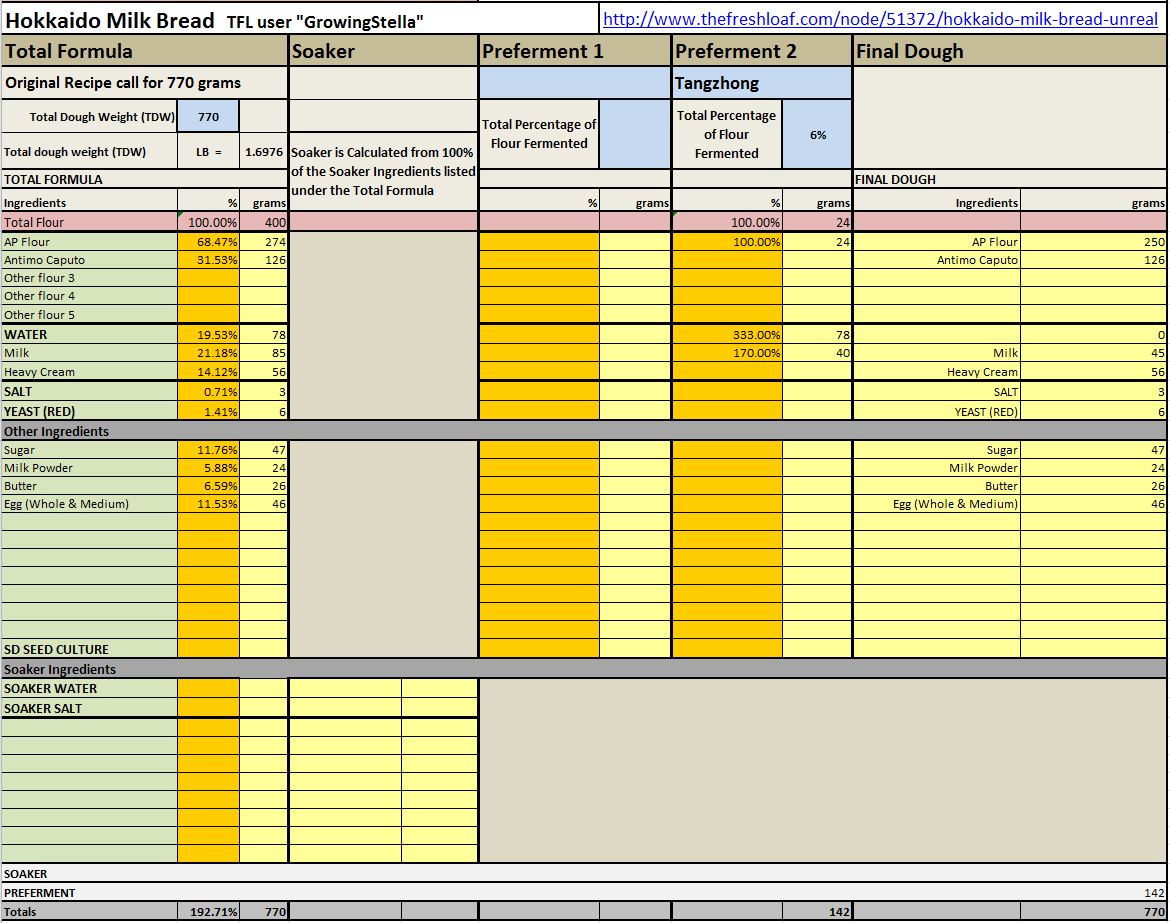
If there is an interested I could setup a download link to the Spreadsheet and also the corresponding recipe instructions. Let me know...
Dan
the bread came out exactly as expected! And the way you were working with the dough, that’s exactly how the dough should feel and be. I agree with you WHOLEHEARTEDLY as to sourdough preference As opposed to white bread. I was thrilled to bake my sourdough every time, there is something in this process that facinates me! But I cannot bake only if I am eating them, so decided to listen to the the crowd lol, my family wishes! Lol
and to add to that Brioche has more flavor and in my openion the most enriched bread having milk, butter and eggs in it. And I mastered it too...so focaccia and brioche are my family’s favorites...my son absolutely loves the german soft pretzels, amd It became a regular.
you mentioned, egg wash caused the bread to stick slightly, yes, it can certainly cause it, basically, it acts like a glue. And with brioche, too, have to use just enough egg wash to not cause it to spill under the bread...
anyway,your baking looks fantastic and thank you for the spreadsheet!
I decided to make this again. Tomorrow morning it will be used to make “Lost Bread, Pain Perdu”. It is going to be a treat.
A heavenly cloud couldn’t be any softer. You’ll have to try it to find out for yourself.
Thanks again, GrowingStella for a great formula.
Danny
By the way, I’m not sure if the low salt percentage listed in the spreadsheet above is correct or not. It seemed way too low so I went with 2% salt instead. That worked out fine.
I am so happy for you! It looks fantastic! And yes - it’s a prefect name for it - heavenly cloud!
i made a long break from baking being so busy with work...but then my job changed and I had more time to bake!
i jumped to no less then baking macarons, then after making them perfecting them, went back to baking bread...and making pizza for family..,
my latest thing is baguettes..we all just absolutely love them!
so great to hear from you! Be safe at these crazy times!
Hi Dan,
Curious about why you "had to resort to the dough hook in order to knead the dough properly." I made this loaf yesterday using the roller and scraper, absolutely no problems. And today, I made this recipe again (I'll be making eight sandwich/hamburger buns with this dough); no problems with the roller and scraper. Followed the recipe exactly except: after adding the butter, I kneaded the dough for fifteen minutes instead of ten.
My first time with this recipe, a couple of weeks ago, I made a double batch (two loaves) and used the dough hook and scraper (based on your trepidation about the R&S) and I found the process not easy: I had to keep moving the dough off the hook (with a silicone spatula) during the entire kneading time. That's why I tried the R&S yesterday. Next time I do a double batch I'll try the R&S and see how that works.
BTW: a huge shout-out to StellaGrows for this fabulous recipe !!
Glad it worked for you. The recipe is phenomenal!
I just got great results with your version of the recipe, my first try using another recipe caused me no end of trouble with a very sticky dough that was really difficult for an inexperienced baker. Your version was a joy to work with, now waiting for them to cool. I got 6 dinner rolls and 4 good size burger buns or sandwich rolls, can’t wait to try them they look amazing...thank you.
i am really happy you liked it and got a great result!
Thank you for the wonderful feedback!
happy baking!
Allie, would you post your ravioli pasta formula and method? I assume it would be good for noodles also. Getting ready to make some Milk Bread burger buns. Plan to slice them open and freeze some for later use. I hope this works for them. When we barbecue I hope to avoid the additional stress of baking buns that morning.
Have you researched heated milk and/or baker’s dry milk vs pasteurized milk from the store?
When I want a soft, cloud-like bread, your Milk Bread is my go-to!
Danny
Give me a little time! I’ll post it 😊
glad the milk bread is one of your faves!
No, never researched this aspect, interesting question though!
I will post the recipe here.. 👍
Dan,
here is my formula. Before dive in, I want you to know why the simplicity of this pasta recipe wins for me personally. I like the pasta to be super tender, super thin, and with full flavor going on in the stuffing. also, I never froze them. I have a feeling that such thin pasta as I am making it may be better off freshly made every time.
The basic flour to eggs proportion is 80 g flour per 1 large egg. You can als ale up as needed.
for 30 (medium to large, not jumbo) size of ravioli
240 g pasta and gnocchi flour by Antimo caputo (I know you will ask if AP flour will go? yes, but do you want to make good ravioli or legendary?)
3 large eggs
1/4 tsp salt
1.5 tsp olive oil
if you make it by hand - pour flour on a board and place other ingredients in the center, using fork start mixing them from the center and out, form the ball and start kneading it, till it’s elastic. Refrigerate it for 30 min.
You can absolutely make it in a mixer. And also, till it’s elastic. Watch it.
rolling it also, can be done by hand or in the pasta machine. I recommend pasta machine that attaches to KA. Right now, don’t have it, I switched mixers and using Kenwood. I’ll have it by an attachment to it as well. The reason it’s great is brocade it allow to make it as thin as I like it, that’s is - YOU CAN READ SMALL NEWSPAPER FONT THROUGH IT.
once it all rolled out, place staffing inside. My family like ricotta ravioli. But it’s a matter of taste and what you’d like to use. 👍
as you make them, use semolina flour to sprinkle on them. They should dry out a little, and you place them in the fridge till ready to cook them.
they are so thin they cook very fast, anywhere between 5-10 min (too). And again, since they are so tender I don’t thought them in a strainer I pick them up out of the pot with a slotted spoon.
enjoy!
Thanks for the formula and instructions!
I want to be sure to get the right flour. Why go for good when you can have legendary? LOL
Is THIS FLOUR correct?
Sure! Enjoy!
Yes that’s the correct flour and that is where I buy it! 👌
Thanks
Best pasta (by far) that I have ever made.
The pasta formula seems basic with nothing unusual. But the flour and also the thin sheets used for the Ravioli makes this special. I ran the dough through the pasta machine until it was on the thinnest setting. It was extremely delicate to work with, but the texture and flavor was outstanding. The Ravioli was filled with ricotta, cheese, and pesto. It had a white béchamel sauce ladled over them.
By the way - the pasta sheets were also very good in Lasagna. The sheets were a bite thicker but they too were very tender and enhanced the texture. You are right. The flour makes a big difference.
I am impressed with the pasta and gnocchi flour by Antimo Caputo and plan to use it in the future. This will be my go-to pasta formula and flour. It was mixed using a spiral mixer and it worked out well, but had to add extra flour. Since the weight of eggs vary, next time I plan weigh out the eggs and adjust the flour for my spreadsheet.
Left over ravioli and lasagna are much better (IMO) the day after. Much Better!
Thanks for sharing,
Danny
Still diggin’ the Caputo flour! It makes a huge difference in the pasta.
Allie, I had originally stated that the egg to flour ratio required more flour for me. But I learned something new that changed my mind. Doc.dough mentioned that he mixes his pasta dough and then lets it rest before kneading. This breaks with tradition of resting the dough after it has been thoroughly kneaded. Doc suggestion made sense to me and after trying it his way, I found that your egg to flour ratio is fine. The weights come out to 50g eggs to 80g flour. The kneaded dough is always rested also to allow the gluten to relax before rolling out.
I just rec’d a pair of pasta cutters straight from Italy, so Agnolotti hade to be made pronto. The black pasta used Squid Ink. I am crazy about THIS PASTA STAND.
Even had enough to freeze for a later date….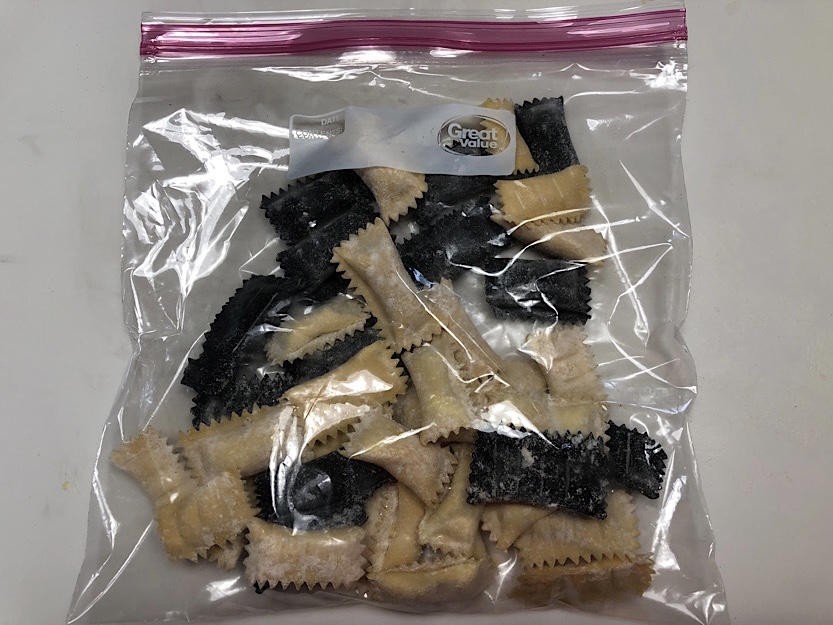
Nice looking agnolotti, Danny! When you say 50g eggs per 80g flour, I presume that it is the weight of eggs without shell?
Lance
Yes Lance, no shell included. Large eggs (in USA) weigh in at ~50g each. The dough will mix up a little wet. But if you let it rest after mixing more of the liquid will be absorbed. I used Caputo Gnocchi and Pasta flour when the calculations were made.
For the last batch the ingredients were mixed on the counter, Italian Style. Then kneaded by hand about 10 minutes.
I am studying up on Gnocchi and Garganelli right now. This is my next direction. Just got a pasta board.
BTW - I used squid in in bread but didn’t like the flavor much, but it is nice in pasta.
My goto recipe for gnocchi is Marcella Hazan's. They are eggless and if you get them right, they are fluffy clouds - though we have occasionally made - and often tasted elsewhere - what our family calls "bullet gnocchi".
You are right to get the little ridged garganelli board - it make gnocchi shaping a lot easier.
Lance
A trick I developed for making pasta dough - work backwards: using a Kenwood or equivalent, measure the egg into the bowl and mix for a few seconds with the K beater. Now trickle in the flour and mix until the dough comes together.
Now change to the dough hook and knead/stand as required.
Lance
Hello, I love the sound of this bread but have some questions. I would like to make four loaves at a time. Does someone know the math on that? If we have 4 separate parts for each loaf, I would think you would end up with rolls. How does this work in the pan? Pictures will not help. I need text descriptions.
You would like to make 4 separate loaves out of the same amount of dough? Or you want 4 loaves consisting of the 4 sections?
if you want to separate them, just don’t put them together. These were 4 separate loaves just placed together in a larger pan. You can bake them in smaller mini pans. And the dough, I believe was used to make rolls as well.
If you want to make 4 loaves at a time and each to have 4 sections - just scale up 4 times.
I personally did not do large bales like that. Hope this helps!
So, I made a typo - it’s milk powder- not “mill” my apology…
scaling up means just multiply for as many loaves as you want to make - times 2 or times 3 …
but I think, you imagine these sections are 4 large loaves - no, these are smaller sections - like rolled separately, and them just placed together next to each other in one single pan. If you separate them - it’s totally fine but these rolls would be very small, like an individual roll, maybe for 1-2 person.
these 4 sections together, is one large loaf, I place them next to each other.
I will also review the recipe again. I did not do it in the longest time lol…just in case ok? And I’ll reply to you in addition to this comment …
Forming logs bell creat this layering structure and help achieve proper texture, proper rising of the loaves
Your scaling will result in 4 of 4 4 sectioned loaves. It’s a lot of bread, unless you give the away, just bake them fresh.
For my family 1 recipe is 1 large 4 sectioned log.
but if that’s what you are planning - you will get 4 4-sectioned loaves and you will need to have 4 large bread pans too. And you will need a very large bowl to rise such large amount of bread dough. It will be about 3 kg of dough - in volume as it is - it’s a lot - as it is rises you will encounter a problem unless you have a pretty large smaller but commercial size of equipment …try one loaf first, and see how it will work out. Again this 1 loaf has the 4 sections together . As they bake they fuse together and they you pull them to separate and you see this amazing effect while pulling them apart lol…
Tangzhong
25g - AP flour (I always use KA) x 4 100g
125g - mixture of water and milk (42g milk and 83g water) x 4 - 500 g (168g milk and 332g water)
As you see, the classic ratio in tangzhing 1/5.
Final dough
400g flour (a combination of KA AP four and Antimo Caputo 00 flour 2/1 ratio) x 4 1600 ( ration 2/1 1100/500 - is approximate, not exact, and it’s fine)
50 g - cast sugar x4 200g
90g - milk x4 360g
60g - heavy cream x4 240g
25 g - milk powder x4 100g
1 egg x4 4 eggs
2 Tbsp - butter x4 8 tbsp
2 tsp - instant yeast x4 8 tsp yeast
1/2 tsp salt x4 2 tsp
tangzhong mixture
this is a very large batch of loaves 4 large loaves - consider how to ferment and let the dough rise properly.
happy baking
If I understand your concern, you want to know how the 4 pieces of dough are used to make a pan loaf. If that is the case these images may help even better than text.
It’s great you shared these images! 👍
This looks so good! Bookmarked. Never done a loaf like this before but your success really wants to make me try it.
Lovely.
absilutely, try it, it's really really good! I am glad, I inspired you :-)
I'll also add my admiration of this beautiful loaf. I still have not tried a tangzhong based bread yet, but this may give me a desire to do so. Thanks for the lovely post.
thank you for such nice words!
and I want to add that some people just make it look like it's a complicated method, but really is not, and so much fun!
The ingredients for tangzhong could vary, like milk or water or a mixture of both. And this method can be used in so many different breads, not only milk bread. You can convert almost any recipe to use it with this method. What you have to do is to take these ingredients out of your original recipe, not to add to it. And make the tangzhong in the ratio 1to 5 - flour to liquids, again out of your original recipe.
But the Hokkaido milk bread, is where this method was used originally, invented by a Japanese baker.
happl baking!
Very well done.
thank you very much!
Beautiful loaf and so rich, congratulations. I got a Hokkaido milk bread gift from my neighbor who likes baking Asian pastries and breads. It was delicious and it kept moist for longer than a regular sourdough. I guess it is the result of using the Tangzhong which helps to trap moist in the dough. I have seen some German sourdough recipes using a similar Tangzhong idea, which I should try one of these days to see whether the moist can be kept for longer.
I've made several loaves from this recipe. The results have bee just outstanding, truly wonderful. A couple of days ago I made the recipe again but, this time instead of a loaf, I made twelve buns. Adjusted the time to 17 minutes, temperature to 375F. Fantastic. Thank you, Stella, thank you for this recipe.
Peter, They look amazing!! Bravo!! Such delight! So happy it worked out great for you! ???
I wanted to try different dough weights to learn which size bun I wanted to bake. Below are my results.
BTW - these were made using THIS FORMULA & INSTRUCTIONS.
NOTE - For burger and hot dog buns only I plan to increase the hydration a bite to facilitate better shhaping. The dough was very elastic. The hydration is great for a typical Pan baked Milk Bread.
Dough weights are in same order as above.
Dan, good work. My regular hamburger dough is 100 grams and suits 4 ounce/113-gram hamburger patties. Yum. I usually make them using brioche dough.
Cheers,
Gavin
It looks very appetizing. I like baked goods with milk, but usually they are sweet buns with poppy seeds or jam. I have not tried baking bread with milk, but it seems to me that this is a good solution.
The bread looks great, wrote down your recipe, I want to try baking it today. Thanks!)
ok, Just tried your version of japanese milk bread. Came out really nice
Strider, they look beautiful!
The bread will be soft as a pillow…